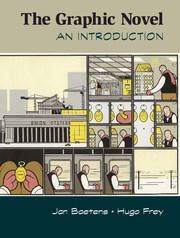Book contents
- Frontmatter
- Contents
- List of illustrations
- Acknowledgments
- 1 Introduction: The Graphic Novel, a Special Type of Comics
- Part One Historical Context
- Part Two Forms
- 5 Understanding Panel and Page Layouts
- 6 Drawing and Style, Word and Image
- 7 The Graphic Novel as a Specific Form of Storytelling
- Part Three Themes
- Notes
- Index
5 - Understanding Panel and Page Layouts
Published online by Cambridge University Press: 05 October 2014
- Frontmatter
- Contents
- List of illustrations
- Acknowledgments
- 1 Introduction: The Graphic Novel, a Special Type of Comics
- Part One Historical Context
- Part Two Forms
- 5 Understanding Panel and Page Layouts
- 6 Drawing and Style, Word and Image
- 7 The Graphic Novel as a Specific Form of Storytelling
- Part Three Themes
- Notes
- Index
Summary
What are the basic formal aspects of the graphic novel, and how do we suggest one can read them for critical purposes? Rather than answering these questions by listing the features that we consider essential, we offer here and in the subsequent chapter some reflections on three fields of interest that are a necessary and an inevitable part of any graphic novel: the organization of the drawings in multipanel pages, issues of word-image combination, and questions of style. These three chosen areas have the advantage of being connected in one way or another to the narrative dimension of the graphic novel that is always, even in its nonmainstream forms, a crucial aspect of any work.
Any productive discussion of the medium can begin with understanding one of its vital and most fascinating properties: panel and page layout. As we explain below, this aspect has received extensive critical attention from scholars working on American and European comics and graphic novels, with Benoît Peeters, Thierry Groensteen, and Charles Hatfield making important contributions. Here we present their approaches and discuss them with reference to notable examples such as Art Spiegelman’s In the Shadow of No Towers and Alison Bechdel’s Fun Home. Gradually we will move to offer a synthetic conception drawing on the existing theorizations that is weighted to neither privilege production nor reader reception.
- Type
- Chapter
- Information
- The Graphic NovelAn Introduction, pp. 103 - 133Publisher: Cambridge University PressPrint publication year: 2014

